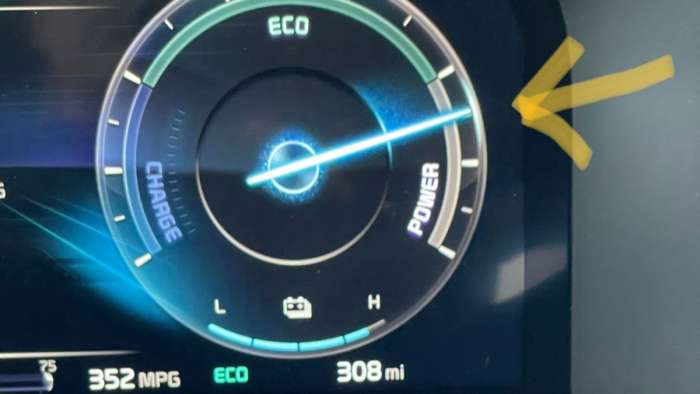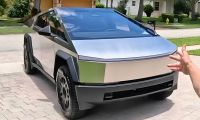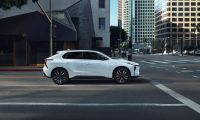Today I performed a new test, as described in a previous article. I drove a roughly 23 mile loop (22.3 miles) twice, once in Auto mode (which leaves it up to the vehicle to decide whether hybrid or electric propulsion is optimal), and once manually selecting between the two. I did this after my first test yielded surprising results; the vehicle stayed in electric mode when I figured it would switch to hybrid. After my second test, I am surprised yet again though this time I feel like I have gotten closer to understanding exactly how the Kira Sorento PHEV “thinks”.
Here’s what happened: On the first loop, in Auto mode as soon as I pulled out of my garage, I started on my route to the freeway (.7 miles from my house). At the crest of a steep hill halfway to the freeway, there’s a stop sign. When I was pulling away from the stop sign, the gas engine suddenly fired up. I looked down at the instrument cluster to check and the car said I was still in EV mode and Auto was showing (and the battery was fully charged!). There was no illuminated “HEV” light to be seen. What was going on?
I coasted downhill most of the rest of the way to the freeway. The gas engine kept running (even though I was coasting). This was totally unexpected, and I wondered why it happened. I think it is probably because I mashed the accelerator down a little too hard on that steep hill at the stop sign. Once the gas engine comes on, it may not shut down right away if the engine block is cold and it was since I hadn’t started the engine before. This makes sense as it would protect the engine from lots of short duration operation, which can wear it out faster.
I came to another stop sign just before the freeway, and then the engine turned off. I glided on electric power onto the onramp, which heads down a long hill, and mashed the accelerator to get to 60 mph before the end of the onramp, which is about a quarter mile down the road. Doing this turned the gas engine back on and that is when I may have distinguished an important part of the Sorento’s decision making logic. Technically, I am guessing, but I noticed when the tachometer needle (right side) touched the second peg in the “Power” band, that is when the gas motor woke up. Below is the point on the tach I am referring to and I think, but will have to test another day, that regardless of which mode the Sorento is in (even in EV mode), when it hits this mark the gas engine comes on:

On with my first loop! The Sorento switched into hybrid mode just before I merged onto the freeway. Traffic was slower today with lots of rubber banding. There were multiple sections on the freeway where 30-40 mph was as fast as I could go. After about 4 miles, it opened up, but the vehicle remained in HEV mode throughout. Also, I noticed that the gas engine warmed up very quickly (via the temperature gauge). Only 8 minutes into the trip and it was already close to optimal temp (1/4 of that in EV mode). I assume that, by design, the gas engine will quickly reach optimal temperature.
The loop included about 11 miles of freeway driving and I hit speeds of up to 75 mph, briefly. I then exited to a 2 lane 40-50 mph highway that goes between two small mountains. There was no traffic to speak of on these roads, so I drove the speed limit or a couple clicks over the rest of the way home. What surprised me here, just as it had as I started out, the gas engine remained on almost the entire way, even when coasting! I could get it to go to sleep sometimes by coasting for a tenth of a mile or so and then very gently pressing on the accelerator, but once the tach got about 1/3 of the way through the “Eco” zone, the gas engine came back on. It felt like the Sorento PHEV was taunting me. You think you’re smarter than me? I’ll show you! Regardless, even though the first loop, in Auto mode, was done mostly in HEV mode, I still got pretty good gas mileage:

48.4 miles per gallon, in a 6 seat SUV/family hauler is nothing to sneeze at. But still, I felt like the Auto mode had let me down. I knew there had to be a way to do better.
Loop 2 was actually done several hours later, just as it was getting dark a little after 4pm in Seattle, these days. The temperature outside was still in the upper 50’s (61 when I did the first loop), in December, in Seattle. The world is turning upside down I tell you! It feels like September out there. I intentionally kept the PHEV in EV mode until about 4 miles into the test in order to better simulate how I would use it on a longer trip. I want to use up enough of the battery at the start so that I can fully capture braking and coasting regeneration; if the battery is full when I go into hybrid mode, I’ll miss some or a lot of that “free” electricity.
At 4 miles I switch to HEV mode and drive the next 7+ miles on the freeway at speeds between 60-75 mph. When I exit the freeway and come to a stop at the end of the offramp, I switch back to EV mode. Traffic is much heavier here this time through the loop and it takes about an extra 10 minutes to finish the drive. My 9 year old daughter is really going to enjoy this. That’s not sarcasm by the way. She is in the middle row behind me, with nothing to play with or occupy her mind besides the “chill” house music on the XM radio station I tuned in to. “Turn up the radio please!” she says, and proceeds to call out her kitten’s name to the steady beat of the music. Note, she is doing this because the kitten’s name is Chili, and she thinks that’s the name of the radio station. See, traffic isn’t always such a bad thing.
Not surprisingly, the Sorento stays in EV mode the rest of the way home. I am being careful not to punch the accelerator, and the vehicle has adequate power to make it up hills without need of gas assist as long as you aren’t laying into the pedal too hard. I get home, and sure enough, I am smarter than my Kia Sorento PHEV, this time:

151 mpg, with a kid in the back seat and the headlights on and the house music thumping, is much better than 48.4 mpg. So, not that I have definitively figured out how the algorithm in the Kia Sorento PHEV works in Auto mode, I have gotten closer. Hey Kia, would you be open to providing us with more specific information on how your PHEVs decide when to be in HEV or EV modes?
Until we might hear from Kia, additional tests may have to prove things out and I am planning my first real road trip for more testing, after I can get a shattered window replaced on my Sorento (thanks criminals!). Here’s how I think it works though: There is a speed at which the gas motor will come on and I believe it is around 75 mph (I read this online, but haven’t tested it yet, technically). There is also an accelerator position or tachometer peg at which point one can also force the gas engine to come on (see my first photo, above). This sounds familiar. I read in a European Kia PHEV user forum that someone had heard from Kia Italy, regarding the Kia Exceed PHEV, that speed and accelerator position are two factors. If that is true for the Sorento, that means there are also road conditions that might encourage the Kia PHEVs to turn on the gas motor (something else I will have to test the first time I take it offroad or in the snow I guess). We’ll have to keep testing for now. Please leave any feedback or your own testing results below in the comment section.
Justin Hart has owned and driven electric vehicles for over 14 years, including a first generation Nissan LEAF, second generation Chevy Volt, Tesla model 3, an electric bicycle and most recently a Kia Sorento PHEV. He is also an avid SUP rider, poet, photographer and wine lover. He enjoys taking long EV and PHEV road trips to beautiful and serene places with the people he loves. Follow Justin on Twitter for daily KIA EV news coverage.












Comments
Good thinking to check the
Permalink
In reply to Another question about my by GLENN DELLINGER (not verified)
Good thinking to check the elevation Glenn. It would make sense, however your elevation check doesn’t seem to explain it. But worse traffic might be the reason why. Any electrified vehicle, plug-in or not, will get better mileage/efficiency in stop and go traffic or in traffic moving around steady 50mph, or less. Constant speeds over 50 equals worse efficiency. This would be my guess why your mpg is better coming home... that or you may just be driving with a lighter foot, or the weather is a little warmer (batteries do like to be “warm” too, and your tires PSI might go up a little, depending on the temperature differences, which could decrease rolling resistance). All those other things would be minor though, and the stop and go pace would be the most impactful on your efficiency. Maybe you can observe how much more stop and go you do coming home vs. going to work and if it seems to work out that way, it is probably a good guess.
Thanks for the reply. Do you
Permalink
In reply to Good thinking to check the by Justin Hart
Thanks for the reply. Do you think charging it right before you leave matters? Yesterday I did not plug it in until 4 hours before I left and just got charged before I left and it got 150 mpg. Thst is a huge difference. It was a warmer day yesterday
Good question! I think in
Permalink
In reply to Thanks for the reply. Do you by GLENN DELLINGER (not verified)
Good question! I think in general, it doesn’t make too much difference, unless your PHEV is sitting there for days with a full charge. By design, you aren’t able to charge the battery to 100% capacity, nor discharge it to 0%. I think ideally you just have it charged to your desired capacity within 24 hours of your next drive and that’s just fine. The battery likes to be the perfect temp though (around 70F) and if it is very cold out, charging it just before you leave “preconditions” the battery so you may see a slight bit better range by charging it up just before you leave when temps are below 40F.
Very interesting conversation
Permalink
Very interesting conversation as to algorithms in software of an PHEV. Why must it be known? What advantages could be derived? On my PHEV, a sister company Hyundai Ioniq, I have determined two choices/techniques: a-its default mode is EV; as in the car is set up by professionals after extensive research and setting parameters to achieve max miles in EV and Hybrid Mode. b-select hybrid mode because cabin heat is needed, or because in planning a trip, I’ve decided to start on EV Mode then, to preserve EV miles for use at destination, select hybrid mode. Notes: “smashing” the accelerator is an emergency move. The engine starts when in EV mode because the 60 hp electric motor needs help; also when the magic decides and I don’t need to puzzle over why. THE end goal is to use electrons to the max and fuel to the minimum. I guess I am not a writer looking for material, but, I’m puzzled as to why an owner could mystified to these levels. Pressure on the gas pedal IS the factor as to efficiency in most cases. BTW, going downhill in EV mode could start and keep the engine running to provide engine braking so as to not cook the brakes. Overall, the Hyundai/Kia PHEV platform is quite exceptionally good with my only wish being have a battery range higher, closer to 45 miles. Lastly, Average Joe/Jane drivers do a rather inadequate job of efficient driving with roof fast acceleration always, rushing to red lights/stop signs and driving in excess of 70 mph. I’ve managed to achieve 63.7 MPG on hybrid mode at 64 mph enjoying the sights, using adaptive cruise control, and LKA. Great technology. Oops, I almost forgot, using the AC on AUTO mode must be acknowledged as not fuel efficient. That is another mysteriously programmed feature. Thanks
It is simply because I know
Permalink
In reply to Very interesting conversation by Ray Cardona (not verified)
It is simply because I know enough about the way my Sorento PHEV operates, and how other PHEVs operate, to know that I can achieve better performance (i.e. efficiency) than the vehicle can leaving it up to the vehicle to decide what mode I should be in. I fully appreciate all the engineering that Kia put into their vehicle, and I also appreciate that most people don’t want to think so much about how they drive or what to do, they just want to get good gas mileage. But it is exactly as you said, most people don’t do a good job of driving efficiently, but I do. I am regularly getting 40-43 miles per charge out of my battery in a 4,500 pound 3 row SUV that is only rated for 32 miles per charge! my lifetime miles per gallon is currently 68 miles per gallon, though that is only because I took a number of long road trips this summer (which require more use of gas). My average, once I get a full year of driving, is going to be closer to 80 mpg, or maybe more.
And one great thing about EVs and PHEVs are the brakes, because some portion of applied braking can be done by the motor generators spinning in reverse and regenerating charge in the battery. My Tesla is so good at it that I hardly ever have to use the brakes (only for panic stops or perhaps if the car is full of people and stuff and I have to stop quickly). Going downhill is almost always an opportunity to regenerate charge and should probably never require the engine to start in a PHEV (only if your battery is fully charged already, and generally speaking, unless you are going down a long steep hill at the very beginning of a drive, you should never be in that situation - always use up enough charge from your battery before a longer trip to recoup any and all charge you might be able to get from coasting and breaking).
Hi Justin, been reading your
Permalink
Hi Justin, been reading your articles on this site about the Sorento phev, I'm getting mine this week and was just wondering if you know whether or not it's safe to leave plugged in and charging over multiple nights? I probably won't be driving it daily so I'd like to try not to waste electricity if possible. Is it better to unplug it after it reaches a full charge?
The only times I would worry
Permalink
In reply to Hi Justin, been reading your by MattO (not verified)
The only times I would worry about leaving it plugged in is 1. in a lightning storm (have read of a few instances where people’s garages have been struck by lightning and caused damage to the car or charging apparatus) and 2. if the cables are in the way of something that might otherwise damage them (garage door, etc.). I leave mine plugged in for days on end and have done so for over 11 years, never been an issue.
I just bought a new 2022
Permalink
I just bought a new 2022 Sorento PHEV SX-Prestige. So far, so good, although my wife complains that the ride isn't as cushy as it was in the Dodge Durango that we traded in. Anyway ... For the last few years our other car was a Hyundai Sonata PHEV, which we really like. It has three modes: EV (charge-depleting), HEV (charge-sustaining) and CHG (charging). That last mode is nice if you are nearing the end of a long drive, you're on the freeway (so the ICE must run anyway), and you're coming into a city where you'd prefer to have a 'fuller' battery to make city driving quiet and efficient (and locally less-polluting). It doesn't appear that there is any equivalent mode in the Kia Sorento PHEV. I'm mildly disappointed in that. Am I correct, or did I miss the equivalent of Hyundai's CHG mode?
hi Barry, I'm a new Sorrento
Permalink
In reply to I just bought a new 2022 by Barry Schader (not verified)
hi Barry, I'm a new Sorrento owner and 4 foot 10 and had problems initially with being able to be at the right height. I added a 3 inch ERGO seat gel cushion and a back cushion bought off of Amazon. I can see over my Sideview mirror and it's so cushy now.
Everyone is over thinking
Permalink
Everyone is over thinking this. Just let the car do it's best to figure out optimum energy consumption. Why worry about the cognitive overload while driving?
Everyone needs to remember, this is a large heavy car for a plug-in. If you drive at mostly fast highway speeds, the battery isn't large enough to help you with a lot of efficiency. It wasn't designed for this. If you drive 40 mph to the local grocery store 7 miles away, and back home, this vehicle will save a lot of gas if you start out with a mostly full battery. Need more? Buy a BEV like a Tesla, and get 100-125 MPGe everywhere you go.
We’ll, I beg to differ,
Permalink
In reply to Everyone is over thinking by RightFoot (not verified)
We’ll, I beg to differ, respectfully. The Sorento PHEV has enough EV power for most (definitely not all) daily driving situations. I can accelerate to freeway speed just fine in the congested area I live in (Seattle, has some of the worst traffic in the country, as bad or worse than places like NYC or San Francisco). Only going up extremely steep hills, or when I need to accelerate hard, suddenly (speeding up to get out of the way for example) do I ever really need to use the gas engine, though from time to time I do press just a little harder on the pedal than I may need or intend to and that can fire up the gas engine (seems to happen about once every month or two). I much prefer the way Chevy implemented PHEV tech in the Volt, but I do get why most PHEVs aren’t that way (its more complicated and requires a more powerful electric motor, and likely a larger battery).
I also never experience “cognitive overload” while driving because driving is an activity that one should always be specifically focused on while doing. Maybe I just have an overactive brain, but I am hyper vigilant about all that is going on around me and have plenty of “bandwidth” to pay attention to what my feet are doing on the pedals and what I want to car to be doing. Maybe as I age, this will be harder to sustain.
HELP! My 2022 Kia Sorento
Permalink
HELP! My 2022 Kia Sorento plug in Hybrid has been perfect for 14 months! Love it. This morning, it is dead. Battery is 98% full, but it isn't recognizing either key. I can't get in, can't open doors or trunk, obviously can't start it. Not even sure if I could tow it, without being able to open doors. Service is closed its xmas Eve. Anyone know how to fix this?
I may be wrong, but this
Permalink
In reply to HELP! My 2022 Kia Sorento by William R Lucas Jr (not verified)
I may be wrong, but this sounds like it may be a dead/depleted 12 volt battery (the one that is in your trunk, under the cargo bay flap). At least this kind of behavior is something I have seen/heard about happening with other plug-in hybrids. At this point, you may have already gotten it addressed (I apologize for not being faster to respond). If you are in a cold area, and the temps have been especially low, that could be what killed your 12V battery (if that’s the problem). Otherwise, you should be able to bypass the electronic lock using your manual key (it is embedded in the key fob). Check your manual for more instructions… at least then you should be able to open it up, check the 12V battery, maybe jump start it if that is what it needs. Good luck!
Hi Justin , Has anyone…
Permalink
In reply to I may be wrong, but this by Justin Hart
Hi Justin ,
Has anyone tested the PHEV with empty fuel tank and only with fully charged battery ?
How does the car work then ? Will it work and drive in EV only if there is no fuel ?
What will happen if we switch AC or boot it ? and there is no fuel ?
Please let me know
I am a KIA SORENTO PHEV owner since 2 days
Pagination